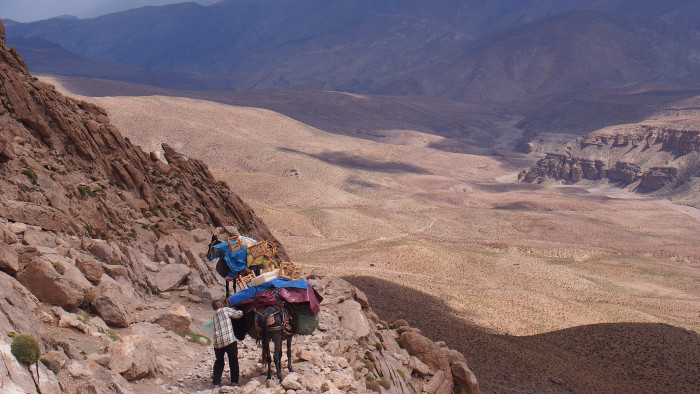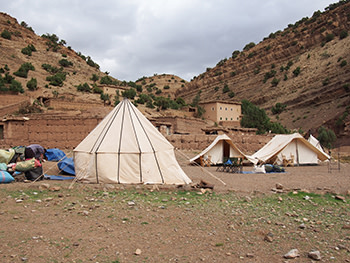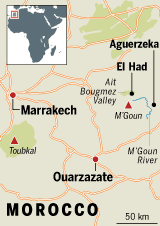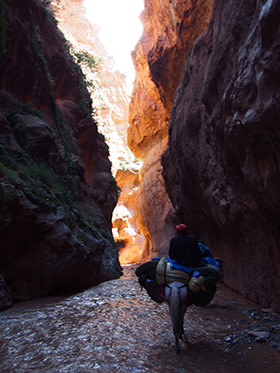Morocco: lost in the Atlas

Simply sign up to the Life & Arts myFT Digest -- delivered directly to your inbox.
I dip fresh bread into runny eucalyptus honey as a mule nuzzles my shoulder. This is my first camp breakfast as I sit at a low, white-linen covered table in the M’Goun Valley, one of the most isolated in Morocco’s High Atlas mountain range, between two 2,900m passes, Tizi n’Ait-Imi and Tizi n’Ait-Ahmed. Sun gilds the crags but M’Goun, at 4,068m Morocco’s fourth-highest peak, is still wrapped in cloud. Its bare flanks are in deep shadow. Out of the sun one feels the altitude; in it, the heat is relentless.
It is a very different landscape to Ait Bougmez, or Happy Valley, where we started our four-night trek the previous day, near the village of El Had. Unlike the tightly packed peaks and troughs around Mount Toubkal – visited more often because it is closer to Marrakech – Ait Bougmez is a sun-drenched avalanche of green fields cascading for 15km, its rich soil the legacy of an ancient lake.
It is warm in Happy Valley, the air sweetened by pine sap. But in the M’Goun Valley a cold wind is blowing. The landscape is austere, like bones picked over by a vulture: ribbed cliffs, scoured backbones, barely arable. There are just a few trees at this altitude – some junipers and sagebrush – and a silver curl of river formed by springs bubbling from the foot of the mountain. We sleep here beside the slow-moving water.
This trek is not for everyone, with 20km-a-day walks and a rigorous 1,000m ascent on the first day. The star-packed nights are chilly, the coffee poor (granulated, and served with powdered milk) and the mobile toilet in a tent of its own is hardly the Four Seasons. Yet we are enjoying more comfort than most. Lawrence of Morocco, the tour company that I’m travelling with, has previously used simple “igloo” tents on this route. I’m a guinea pig as the company trials a new, more elaborate style of camping, using white canvas tents with real mattresses and en suite tents for a hot “bucket” shower. The Berber-style lamb ribs are mouthwatering. The linen is snow-white. The beaten brass bowl I’m given to throw steaming water over my body is one of those small but significant luxuries that puts me in mind of the classic mobile safaris popular in the Serengeti.
At one time, this wouldn’t have seemed such a far-fetched comparison. At the turn of the 19th century there were still Barbary lions in these mountains. In Roman times, elephants. Now the big game has gone, replaced by the moan of mules and an occasional dog barking at its own echo. Both are indicators of a Berber village coming up: built of straw and ochre mud from the mountains, these flat-roofed homes are low-lying and camouflaged by the red-earth palette.

Nine local Berbers are our guides and muleteers. They carry the mobile camp: the food, pots and pans, the brass kettle and mirror for our ablutions, the beds and duvets (all the tentage is supplied by the same Frenchman who helps kit out the world’s toughest foot race, the Marathon des Sables, held every year in southern Morocco). I’m with two friends, meaning three staff to each guest. This ratio is standard for this private trek, and also means that there’s always a mule on hand for each of us to ride should we grow tired.
It is this option that we’re discussing over breakfast. One of my companions is unsure if it’s humane. The mule is already loaded with camping kit and to that would be added her 60kg. My other companion points out that if she doesn’t ride it, the muleteer will – and he’s much heavier. Still, the animals are well looked after: plump, sure-footed, with their heads deep in nosebags.
The crew isn’t listening to our sentimental chit-chat. They’re talking among themselves – the guttural, hard-edged dialect and the speed with which they speak suggest one of them might have called the other’s wife a donkey. Our Berber guide, Abdellah Allali, points out the cause of the commotion: a camel train, 20 animals long, moving like a thread of gold across the confluence of the Oulilimt and Amougr Saln rivers just behind us. The muleteers are shouting because they so rarely catch the spectacle.

If modern Morocco is trying to throw off the manacles of Orientalism, then this tableau sets its endeavours back by a century. It is absurdly picturesque, like something Delacroix might have painted. A group of black goats scatters at the camels’ presence, scaling the rocks until they’re clinging to the crags like ants to a blade of grass. Then, within a few minutes, the camel train is gone. It has disappeared around a bend in the valley, and behind a ruined kasbah with slit windows and crumbling walls. Once used to exact tolls, these days it provides shade and a makeshift home to a family of Berber goat herders.
Our guide remarks on how lucky we are to catch this migration. The camel train belongs to a semi-nomadic tribe called the Ait Atta. From September to June, they live in the Jbel Sarhro mountains in the Anti-Atlas range. In the summer months they relocate to the M’Goun Valley (we had seen some of the caves they’re known to inhabit on our descent from the first pass). We caught them at the beginning of their 11-night journey: children crying, women with chickens under their arms, goats with their legs tied and slung over the shoulders of mules.
If Morocco is the most exotic place to visit within the shortest flight time of western Europe, then its High Atlas region has to be among the most remote and ancient. The Berber language is related to ancient Egyptian. The symbols that the Berbers weave and paint on houses predate the Roman Empire. The M’Goun Valley’s Berbers – desert people forced into the mountains from the seventh century onwards under successive Arab dynasties – are at least a day, if not two, from a shop. “Going to market on a donkey is like going on a bicycle,” says Allali. “Going on a mule is like going in a car.” There are no vehicles, no roads. Government schemes to get electricity into the valley have not been wholly successful. The school, built by an NGO, is without batteries. The women we speak to as we pass through the villages have no less than five children each. One has nine.

Yet these people aren’t going hungry. This becomes clear on our second day when we progress through the M’Goun Valley into its irrigated heart. A neater patchwork of fields and orchards is hard to imagine: apple groves, fields of maize, channels of river water shadowed by willows. It’s September, time for the walnut harvest. Many of the trees are thick with children beating fruit out of the highest branches. The chicken our cook buys in the village of Imi n’Irkt, although four times the price of its counterpart in Marrakech, is delicious – cooked up as a hearty tagine.
Admittedly, the smell of blood from the chicken’s cut throat is a little unsettling, but these are country people. The Berbers call themselves Imazighen, which translates as “free people”. They loathe having their picture taken, especially the women, and they are committed Muslims. During our trek the muleteers prostrate themselves on prayer carpets that double as saddlecloths.
We see only one other group of four trekkers as we walk. Otherwise there are no tourists, advantageous at the trek’s climax, the M’Goun Gorges, where any more than a handful of us would block the canyon.
The final day’s walking is actually all in the river. Sometimes the M’Goun flows so hard that I have to tread carefully to keep my balance. At other times it is slow as a brook. The landscape includes ruins of extraordinary ancient homes, gripping the canyon walls like birds’ nests, and terrifying switchback paths up vertical cliffs that the mules sometimes take if the water is running high. Today, right at the end of the summer trekking season (May to September), the M’Goun is almost at its impassable limit.
The gorges are now ahead of us. The route through the mountains narrows to a width of just two metres, between walls of rock more than 100m high. For five minutes we’re up to our thighs in the river while the mules, following in a line behind, only just squeeze through. Then we’re spat out into the South Atlas and on towards Aguerzeka in the Valley of the Roses, which, if we had come in May, would be flowering with the Damascus rose. Instead, the river is lined with pink oleander, then power lines. Coverage returns to my mobile phone. Messages are buzzing in my pocket, each one a reminder that the real privilege of this journey is not the luxurious linen, but the sense of complete escape.
——————————————-
Sophy Roberts was a guest of Lawrence of Morocco (lawrenceofmorocco.com). A full-board M’Goun Gorges trek costs from £2,405 per person, including three nights under canvas, one at a guest house in the Ait Bougmez Valley, and two nights in a pool suite at Les Deux Tours (les-deux-tours.com) in Marrakech
Comments